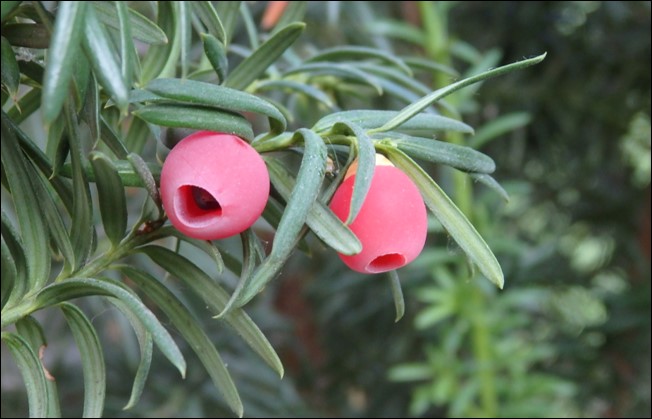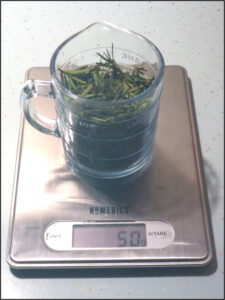
What To Know
By HAYDEN SEDER

The recent deaths of four elk and one moose from yew poisoning have reinvigorated efforts by Blaine County, the cities of Ketchum and Hailey, and the Idaho Department of Fish and Game to educate the public on this dangerous ornamental plant and how to identify and remove it.
“The recent poisoning deaths of local wildlife is another wake-up call and a call to action to prevent further loss,” said Ketchum Mayor Neil Bradshaw. “This is a problem we can fix through learning how to identify the yew tree and then taking the necessary steps to ensure the removal of the toxic plant.”
Wildlife poisoning by yew has been a problem in Blaine County for years, but the deaths of a herd of 12 or so elk in the Hailey Cemetery in December of 2015 by yew poisoning prompted the Board of County Commissioners to pass County Ordinance 2016-01 in March of 2016, declaring Japanese, European or English, and Chinese yew and their hybrids as noxious weeds, prohibiting their sale, planting and possession.
Despite the enforcement of this ordinance for seven years, ornamental yew still poses a threat to local wildlife. While some may be quick to blame newcomers to the area, Idaho Fish and Game Regional Communications Manager for the Magic Valley Region, Terry Thompson, explained that the majority of yew they find are mature plants that have been in the ground for years. “I think it’s easy to blame the new people,” said Thompson. “But it’s everyone. The goal isn’t to point fingers; we just need to get people educated across the board. The solution is simple: getting rid of the plant.”
As a drought-tolerant, low-water plant, yew is often used in landscaping. And while local landscaping companies are aware of the ordinance prohibiting the planting of yew, there is nothing to prevent someone in Blaine County from driving to Twin Falls or Boise and buying yew plants at a garden center and planting them at their home or business. Since yew does not grow naturally nor reproduces in this landscape, any local instances of the plant are completely landscaped and brought in. While the county’s ordinance gives local authorities the right to issue citations—though they have not chosen to do so at this time—it does not give Fish and Game the authority to issue citations, as there is no state law governing the planting of yew.
Since it ultimately comes down to the local level, the Idaho Department of Fish and Game has been increasing education efforts, particularly to the cities of Ketchum and Hailey and the county. In 2022 and 2023, Idaho Fish and Game provided training to city and county employees who are out and about in the community in the regular course of their jobs—people from the assessor’s office, compliance officers, or police officers. “The more people we can get trained to identify the plant who are out and about, the better,” said Thompson.
Fish and Game also held a one-hour presentation for the public on February 28 at The Community Library in Ketchum to educate on yew poisoning and identifying the plant. There were branches of yew at the presentation for people to pick up, look over, and take pictures of to have as a visual reference. Yew, unfortunately, cannot be identified by shape, since some people prune them into highly sculpted, small round bushes while other bushes are allowed to grow to heights of 8 to 10 feet. It is only by needle characteristics that the plant, which looks similar to other local conifers, can be identified. Thompson himself has a paid-for app on his phone for identifying plants, which has reliably identified yew, though he says that free plant-identifying apps are less consistent, so he advises reaching out to city and county officials or Blaine County’s Noxious Weed program to have trained staff come and identify the plant.
“It’s up to each person to inspect their own properties and identify it and remove it,” said Thompson, “because this is, ultimately an issue that will be resolved by the cities and the county.”
And lest you think that yew plants can only kill wildlife, the toxic plant has the potential to kill pets, children, and adults—anything that ingests it. Idaho Fish and Game’s botanist says that the first sign of yew poisoning is death; death from ingestion typically occurs in less than an hour and there is no antidote to yew poisoning. “It’s toxic to basically everything,” said Thompson. “If a dog was to chew on a twig, a person was to eat one of the red berries and crunch up a seed in the berry… one to two seeds can kill a child, three to five seeds can kill an adult. I think one of the main misconceptions is that it’s only toxic to wildlife.”
Whether you think you may have yew planted or not, take the time to look over and identify all of the plants in your landscaping—many yew plants were planted years ago. To report yew sightings anonymously, visit Blaine County’s website’s Noxious Weeds section. Here you will also find more information on yew. If you find yew on your property, it can be disposed of free of charge at the Ohio Gulch Transfer Station but must be separated from other yard debris. If you are unsure if you have a yew plant, please call city or county officials to come and identify the plant.


